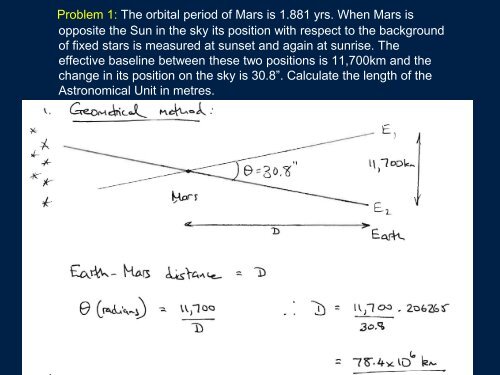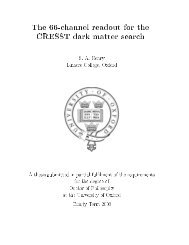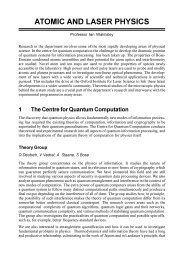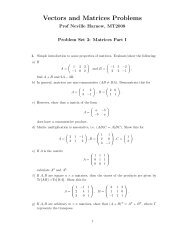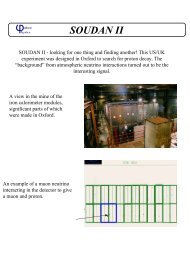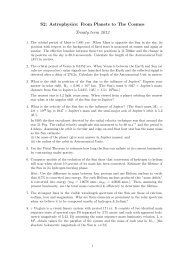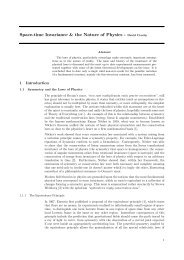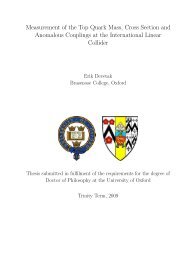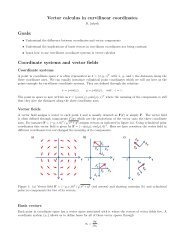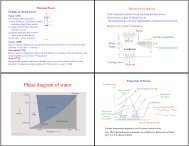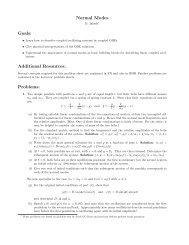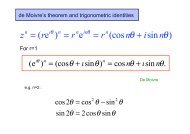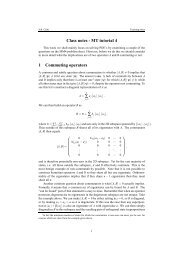Problem 1: The orbital period of Mars is 1.881 yrs. When Mars is ...
Problem 1: The orbital period of Mars is 1.881 yrs. When Mars is ...
Problem 1: The orbital period of Mars is 1.881 yrs. When Mars is ...
Create successful ePaper yourself
Turn your PDF publications into a flip-book with our unique Google optimized e-Paper software.
<strong>Problem</strong> 1: <strong>The</strong> <strong>orbital</strong> <strong>period</strong> <strong>of</strong> <strong>Mars</strong> <strong>is</strong> <strong>1.881</strong> <strong>yrs</strong>. <strong>When</strong> <strong>Mars</strong> <strong>is</strong><br />
opposite the Sun in the sky its position with respect to the background<br />
<strong>of</strong> fixed stars <strong>is</strong> measured at sunset and again at sunr<strong>is</strong>e. <strong>The</strong><br />
effective baseline between these two positions <strong>is</strong> 11,700km and the<br />
change in its position on the sky <strong>is</strong> 30.8”. Calculate the length <strong>of</strong> the<br />
Astronomical Unit in metres.
<strong>Problem</strong> 1: <strong>The</strong> <strong>orbital</strong> <strong>period</strong> <strong>of</strong> <strong>Mars</strong> <strong>is</strong> <strong>1.881</strong> <strong>yrs</strong>. <strong>When</strong> <strong>Mars</strong> <strong>is</strong> opposite<br />
the Sun in the sky its position with respect to the background <strong>of</strong> fixed stars <strong>is</strong><br />
measured at sunset and again at sunr<strong>is</strong>e. <strong>The</strong> effective baseline between<br />
these two positions <strong>is</strong> 11,700km and the change in its position on the sky <strong>is</strong><br />
30.8”. Calculate the length <strong>of</strong> the Astronomical Unit in metres.
<strong>Problem</strong> 2: <strong>The</strong> <strong>orbital</strong> <strong>period</strong> <strong>of</strong> Venus <strong>is</strong> 0.6152 <strong>yrs</strong>. <strong>When</strong> Venus <strong>is</strong> between<br />
the Earth and Sun (at inferior conjunction) radar signals are launched from the<br />
Earth and the reflected signal arrives after 276.2s. Calculate the length <strong>of</strong> the<br />
Astronomical Unit in metres.
<strong>Problem</strong> 3:<br />
What <strong>is</strong> the shift in position <strong>of</strong> the Sun due to the influence <strong>of</strong> Jupiter?<br />
Express your answer in solar radii, R סּ = 69510 3 km. (<strong>The</strong> Sun’s mass <strong>is</strong><br />
1047 Jupiter’s mass, d<strong>is</strong>tance from Sun to Jupiter <strong>is</strong> 5.2AU ).
<strong>Problem</strong> 4: What <strong>is</strong> the velocity <strong>of</strong> the Sun due to the influence <strong>of</strong> Jupiter?<br />
(<strong>The</strong> Sun’s mass, M סּ = 2 10 30 kg, <strong>is</strong> 1047 Jupiter’s mass and the semimajor<br />
ax<strong>is</strong> <strong>of</strong> Jupiter’s orbit <strong>is</strong> 5.2 AU)
<strong>Problem</strong> 4 cont.: In 1995 the first planet detected by the radial velocity technique was<br />
that around the star 51 Peg. <strong>The</strong> velocity amplitude was measured to be 60m/s<br />
and the <strong>period</strong> <strong>is</strong> 4.2days. Assuming the orbit <strong>is</strong> edge–on and that host star has<br />
the same mass as the Sun estimate (i) the mass <strong>of</strong> the planet (give your answer in<br />
Jupiter masses) and (ii) the radius <strong>of</strong> the orbit in Astronomical Units.


